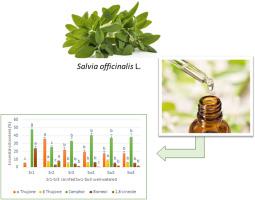当前位置:
X-MOL 学术
›
Biochem. Syst. Ecol.
›
论文详情
Our official English website, www.x-mol.net, welcomes your feedback! (Note: you will need to create a separate account there.)
Effect of harvest time and low water availability during balsamic period on Salvia officinalis L. biomass development, ecophysiological traits and essential oil yield and composition
Biochemical Systematics and Ecology ( IF 1.6 ) Pub Date : 2024-04-10 , DOI: 10.1016/j.bse.2024.104825 Sebastiano Delfine , Carmen Formisano , Carmina Sirignano , Daniela Rigano
Biochemical Systematics and Ecology ( IF 1.6 ) Pub Date : 2024-04-10 , DOI: 10.1016/j.bse.2024.104825 Sebastiano Delfine , Carmen Formisano , Carmina Sirignano , Daniela Rigano

|
Sage ( L.) is cultivated in many countries due to the medicinal and industrial importance of its essential oil (EO). The yield and quality of the crops to be included in the medicinal plant supply chain should be constant, but often this is not the case since they are both influenced by environmental variability and crop management. We therefore studied the influence of water availability and harvest time, during the balsamic period, on a sage crop cultivated at an experimental field site in the Molise Region (South-central Italy), evaluating the main agronomic and ecophysiological traits in terms of plant biomass production and photosynthetic performance. The yield and composition of the essential oils, extracted by hydrodistillation and analyzed by GC and CG/MS, were also evaluated. The well-watered crops harvested 42 days after beginning of flowering, exhibited higher dry biomass yield than rainfed plants as well as higher values of relative water content, photosynthesis and leaf CO conductance. Instead, at the same time (after 42 days) the EO content was higher in rainfed plants then in well-watered ones, in which it remained constant throughout all the harvesting period. All the EOs were rich in bioactive compounds such as α-thujone, β-thujone, camphor and borneol, but only in well-watered plants the content was constant throughout all the harvesting periods. In fact, the EO of rainfed plants analyzed over the harvest time was mainly rich at the beginning in camphor and borneol, whereas in the middle in α-thujone. Our study demonstrates that the crop performance is greatly influenced by the water availability during the balsamic period. The results of this study provide new knowledge to produce sage oil of adequate quality for the different uses.
中文翻译:

香脂期收获时间和低水利用率对鼠尾草生物量发育、生态生理特性以及精油产量和成分的影响
由于鼠尾草精油 (EO) 的药用和工业重要性,许多国家都种植鼠尾草 (L.)。药用植物供应链中作物的产量和质量应该是恒定的,但通常情况并非如此,因为它们都受到环境变化和作物管理的影响。因此,我们研究了香脂期间水供应和收获时间对莫利塞地区(意大利中南部)试验田种植的鼠尾草作物的影响,评估了植物生物量方面的主要农艺和生态生理特征生产和光合作用性能。还评估了通过水蒸馏提取并通过 GC 和 CG/MS 分析的精油的产量和成分。开花后42天收获的浇水充足的作物比雨养植物表现出更高的干生物量产量以及更高的相对含水量、光合作用和叶片二氧化碳电导值。相反,同时(42 天后),雨养植物中的 EO 含量高于浇水良好的植物,并且在整个收获期间保持恒定。所有 EO 都富含生物活性化合物,如 α-侧柏酮、β-侧柏酮、樟脑和冰片,但只有在浇水良好的植物中,其含量在整个收获期间保持恒定。事实上,在收获期间分析的雨养植物的环氧乙烷在开始时主要富含樟脑和冰片,而在中期富含α-侧柏酮。我们的研究表明,香醋期间的可用水量对作物生长状况影响很大。这项研究的结果为生产适合不同用途的优质鼠尾草油提供了新知识。
更新日期:2024-04-10
中文翻译:

香脂期收获时间和低水利用率对鼠尾草生物量发育、生态生理特性以及精油产量和成分的影响
由于鼠尾草精油 (EO) 的药用和工业重要性,许多国家都种植鼠尾草 (L.)。药用植物供应链中作物的产量和质量应该是恒定的,但通常情况并非如此,因为它们都受到环境变化和作物管理的影响。因此,我们研究了香脂期间水供应和收获时间对莫利塞地区(意大利中南部)试验田种植的鼠尾草作物的影响,评估了植物生物量方面的主要农艺和生态生理特征生产和光合作用性能。还评估了通过水蒸馏提取并通过 GC 和 CG/MS 分析的精油的产量和成分。开花后42天收获的浇水充足的作物比雨养植物表现出更高的干生物量产量以及更高的相对含水量、光合作用和叶片二氧化碳电导值。相反,同时(42 天后),雨养植物中的 EO 含量高于浇水良好的植物,并且在整个收获期间保持恒定。所有 EO 都富含生物活性化合物,如 α-侧柏酮、β-侧柏酮、樟脑和冰片,但只有在浇水良好的植物中,其含量在整个收获期间保持恒定。事实上,在收获期间分析的雨养植物的环氧乙烷在开始时主要富含樟脑和冰片,而在中期富含α-侧柏酮。我们的研究表明,香醋期间的可用水量对作物生长状况影响很大。这项研究的结果为生产适合不同用途的优质鼠尾草油提供了新知识。



























 京公网安备 11010802027423号
京公网安备 11010802027423号